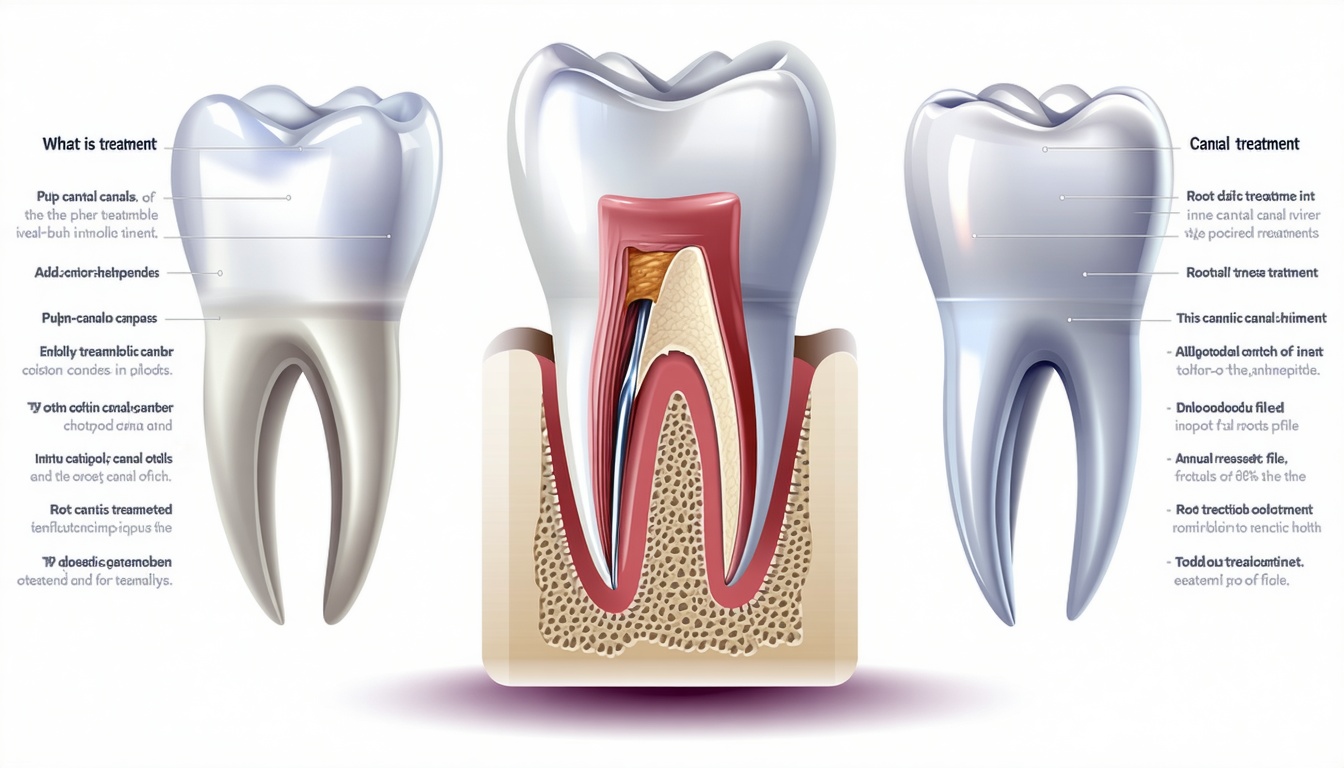Understanding Root Canal Treatment
Understanding root canal treatment is essential for anyone experiencing dental discomfort. This procedure aims to relieve pain, preserve natural teeth, and prevent the spread of infection.
Signs You Need a Root Canal
There are several signs that indicate you may require a root canal. If you experience any of the following symptoms, it’s important to consult your dentist:
- Painful Sensitivity: You may notice prolonged sensitivity to hot or cold that does not subside quickly, which suggests nerve damage within the tooth (Spring Branch Dental Care).
- Swelling and Discomfort: Swelling of the face and jaw, along with pain in the gums surrounding a specific tooth, often indicates a potential tooth infection (Spring Branch Dental Care).
- Dental Abscess: A pimple-like bump on the gums can signify a dental abscess, pointing to a severe infection that may require a root canal and antibiotic treatment (Spring Branch Dental Care).
- Tooth Discoloration: If a tooth is severely discolored (appearing grey or black), this could suggest significant decay or damage, indicating the need for root canal therapy.
- General Symptoms: Other symptoms may include pain, swelling, or a boil on the gums, signaling that immediate treatment is necessary to alleviate pain, save the tooth, and prevent further complications (Cleveland Clinic).
Importance of Root Canal Therapy
Root canal therapy is vital for preserving your natural teeth and preventing more severe dental issues. Here are a few reasons why this treatment matters:
- Pain Relief: It effectively alleviates tooth pain caused by infection or nerve damage.
- Preventing Tooth Loss: By addressing infections and decay, root canals help you retain your natural teeth and avoid the need for extractions.
- Protecting Oral Health: Timely treatment prevents the spread of infection to surrounding teeth and other areas of the mouth.
- Restoring Functionality: After treatment, the tooth can typically be restored with a crown or filling, ensuring it functions properly in your bite.
In summary, recognizing the signs you need a root canal and understanding the importance of this procedure can significantly influence your dental health. For more information on the procedure itself, consider checking what is a root canal or learn about the signs you need a root canal.
The Root Canal Procedure
Understanding the root canal procedure can help alleviate concerns as you consider your options for dental health. This treatment is designed to relieve pain and save your natural tooth, ultimately enhancing your oral health.
Steps in a Root Canal
The root canal procedure involves several essential steps. Typically, the process can be broken down as follows:
-
Diagnosis: Your dentist will perform an examination and may take X-rays to assess the condition of your tooth.
-
Anesthesia: Local anesthesia is administered to numb the affected area, ensuring your comfort throughout the procedure.
-
Access Opening: The dentist creates an opening in the crown of the tooth to access the pulp chamber.
-
Cleaning and Shaping: The infected pulp tissue is removed using specialized instruments. The root canals are cleaned, shaped, and disinfected to prepare for filling.
-
Filling: After cleaning, the empty root canals are filled with a biocompatible material called gutta-percha to seal the space and prevent further infection.
-
Temporary Filling: A temporary filling is placed over the access opening to protect the tooth until a permanent restoration can be done.
-
Restoration: Finally, a crown or similar restoration is placed on the tooth to restore its structure and function.
For more detailed information, you can refer to our article on root canal procedure steps.
Duration of a Root Canal
The time it takes to complete a root canal can vary depending on the complexity of the case. Most root canals typically take about 60 to 90 minutes to complete. However, some cases may require more than one visit, especially if further treatment is necessary or if multiple root canals are involved. Each visit generally lasts around 90 minutes.
| Root Canal Duration | Description |
|---|---|
| First Appointment | 60-90 minutes |
| Follow-up (if needed) | 60-90 minutes |
Success Rate of Root Canals
Root canal treatments have a high success rate, often exceeding 90%. When performed by a qualified endodontist, the procedure is considered a predictable and effective solution for saving a tooth. Most treated teeth can last a lifetime with proper care, which includes regular dental checkups and maintaining oral hygiene (Cleveland Clinic).
The benefits of successfully completing a root canal include saving your natural tooth, preventing infection from spreading, and allowing you to continue enjoying your favorite foods. For more insights on the longevity and effectiveness of the procedure, you can explore our article on root canal success rate.
Recovery and Aftercare
Post-Root Canal Recovery
After undergoing a root canal, most patients can expect a smooth recovery process. The majority of individuals heal within less than a week, with the potential for lingering sensitivity in the treated tooth. Normal activities, such as going to work or school, can typically resume immediately, although some may experience temporary numbness for 2 to 4 hours post-procedure (AAE).
| Recovery Aspect | Time Frame |
|---|---|
| Total Recovery | Less than 1 week |
| Numbness Duration | 2-4 hours |
| Lingering Sensitivity | Possible |
Once the numbness subsides, you can resume normal eating and drinking, including alcohol. However, be cautious about chewing directly on the treated tooth until it is fully restored. Although many people do not experience prolonged pain, it is important to contact your dental provider if pain persists beyond the expected recovery timeframe. For more details on recovery expectations, you can refer to our article on root canal recovery time.
Common Symptoms After Treatment
Post-treatment symptoms can vary among individuals but often include mild discomfort and sensitivity. Understanding these symptoms can help you manage your recovery effectively. Common symptoms include:
- Sensitivity to Temperature: Many experience heightened sensitivity to hot or cold temperatures, which may persist for several days.
- Discomfort: Mild discomfort or achiness in the treated area is normal and should gradually subside.
- Swelling: Some patients may notice slight swelling around the gum line, which typically resolves as healing progresses.
If you experience any unusual symptoms, such as prolonged pain, heavy swelling, or fever, it’s essential to reach out to your dentist promptly. More tips for alleviating discomfort can be found in our article on root canal pain relief tips.
Maintaining good oral hygiene after the procedure is critical. Follow any post-operative care instructions provided by your dentist to support healing and minimize the risk of complications. For guidance on at-home care, review our recommendations in root canal home care aftercare.
Risks and Adverse Effects
Understanding the risks and adverse effects of root canal treatment can help you feel more informed and prepared. While root canals are generally safe and effective, there are potential complications associated with the procedure.
Potential Risks During Root Canal
Several risks may arise during root canal therapy, including:
- Persistent Infection: There is a possibility of ongoing infection before or after the treatment if the underlying cause is not fully addressed. Waiting too long to get a root canal can lead to tooth loss, especially if an infected root goes untreated.
- Instrument Breakage: During the procedure, dental instruments may break, complicating the treatment and extending the duration.
- Tooth Weakness: Post-treatment, the treated tooth may become brittle and more prone to cracking or fracturing because the living pulp, which nourished the tooth, is removed (Dental Perfections).
- Reinfection: There is a risk of reinfection if any part of the treatment is not performed correctly, such as ineffective cleaning or inadequate sealing of the root canals (Dental Perfections).
- Allergic Reactions: Although rare, you may experience allergic reactions to materials used during the procedure, which could manifest as itching, swelling, or difficulty breathing (Ironwood Dental Care).
Managing Post-Treatment Discomfort
After a root canal, it’s normal to experience some discomfort. Here are some tips for managing post-treatment pain:
- Follow Your Dentist’s Instructions: Adhere to the aftercare advice provided by your dentist, as they will give you specific guidelines tailored to your treatment.
- Pain Relief Medications: Over-the-counter pain relievers like ibuprofen or acetaminophen can help manage discomfort. Always consult your dentist before taking medication.
- Cold Compress: Applying a cold compress to the outside of your cheek can reduce swelling and numb the area to alleviate pain.
- Soft Foods: Stick to a soft diet for the first few days after the procedure to avoid putting pressure on the treated tooth.
- Avoid Temptation: Do not chew on the treated side of your mouth until your dentist advises that it is safe to do so.
Maintaining proper oral hygiene after the procedure is essential. Brush and floss gently to promote healing and follow up with your dentist for any necessary check-ups to ensure successful recovery. For more information on recovery, read about root canal recovery time and root canal pain relief tips.
Root Canal Treatment Explained
Understanding the purpose and benefits of root canal treatment can alleviate concerns and clarify its importance in dental care.
Purpose of Root Canal
The primary purpose of a root canal is to address issues caused by badly decayed or infected teeth. When the pulp inside a tooth becomes infected due to bacteria, this can lead to significant pain and inflammation. In such cases, root canal treatment is essential to remove the damaged pulp, clean, and seal the tooth. This procedure not only alleviates pain but also preserves the natural tooth structure, preventing the need for more invasive procedures like extractions. As detailed by the Cleveland Clinic, root canal therapy aims to eliminate bacteria, prevent reinfection, and maintain your natural tooth’s integrity.
Tooth Preservation Benefits
Choosing root canal treatment offers numerous advantages for tooth preservation:
-
Natural Tooth Retention: One of the primary benefits is that you can keep your original tooth intact, which is crucial for maintaining proper oral function and aesthetics. Losing a tooth can lead to complications in chewing and bite alignment.
-
Cost-Effectiveness: Preserving your natural tooth through root canal therapy can save you significant costs in the long term. Treatment typically costs less than tooth extraction followed by dental implants or bridges (root canal vs tooth extraction).
-
Reduction in Pain and Discomfort: By removing the infected pulp, root canal treatment alleviates pain quickly. Many patients report substantial relief post-procedure (root canal pain relief tips).
-
Preservation of Jawbone Health: Keeping your natural tooth helps maintain jawbone density. Losing teeth can lead to bone loss, as the jawbone requires stimulation from the roots to stay healthy.
-
Long-Term Functionality: Root canal-treated teeth can last a lifetime with proper care, allowing you to continue using the tooth for biting and chewing effectively.
| Benefit | Explanation |
|---|---|
| Natural Tooth Retention | Keeps your original tooth and prevents complications associated with tooth loss. |
| Cost-Effectiveness | Often more affordable long-term compared to extraction and subsequent prosthetics. |
| Pain and Discomfort Reduction | Eliminates infection and pain, providing quick relief. |
| Jawbone Health | Maintains the jawbone density through stimulation from the tooth root. |
| Long-Term Functionality | Treated teeth can last for many years with proper care. |
Root canal treatment presents a viable option for preserving your natural teeth while alleviating the discomfort associated with infections. If you suspect that you may need a root canal, identifying the signs you need a root canal can guide you in seeking timely care. Explore more about the procedure through our detailed overview of what is a root canal and the root canal procedure steps.
Cost and Comparison
Understanding the financial aspects of dental treatments is essential. In this section, you will learn about the cost of root canal therapy and how it compares to tooth extraction.
Cost of Root Canal Therapy
The cost of a root canal treatment typically varies depending on the complexity of the procedure and the specific tooth being treated. Here is a general breakdown of the average costs associated with root canal therapy:
| Tooth Type | Average Cost (USD) | Complexity Level |
|---|---|---|
| Anterior (Front) | $300 – $1,500 | Lower |
| Premolar | $400 – $1,800 | Moderate |
| Molar | $700 – $2,000 | Higher |
Most dental insurance policies offer partial coverage for endodontic treatments (American Association of Endodontists). This can significantly reduce the out-of-pocket expenses for patients, making root canals a cost-effective option compared to other dental solutions.
Endodontic Treatment vs. Tooth Extraction
Deciding between endodontic treatment (root canal) and tooth extraction involves various factors, including cost, long-term effects, and overall dental health. Below is a comparison of these two options:
| Treatment Type | Average Cost (USD) | Additional Costs | Preservation of Natural Tooth | Longevity |
|---|---|---|---|---|
| Root Canal | $300 – $2,000 | Restoration needed | Yes | 10 years or more |
| Tooth Extraction + Implant/Bridge | $3,000 – $5,000+ | Ongoing dental work | No | 5 – 10 years, then replacement |
Endodontic treatment is generally less expensive than extracting a tooth and replacing it with an implant or bridge, which can incur significant costs and require additional procedures (AAE). By preserving the natural tooth through a root canal, you can avoid further complications and expenses in the future.
For more detailed information about the costs and benefits of root canals, including the potential for pain relief, consult our articles on root canal pain relief tips and root canal vs tooth extraction.










